Oregon is full of thriving wildlife and birdlife. With so many different habitats and landscapes, it’s really no wonder that nearly 500 kinds of birds have been documented in the state. This includes about 275 regular residents in the state and another 85 that stay here for the winter or stop by on their migration journeys.
Not long ago, we created a list of 25 really cool birds you can see in Oregon, including finches, tanagers, bluebirds, jays, hummingbirds, woodpeckers, knots, kites, skimmers, and more.
But what about sparrows? Sparrows are some of the most commonplace birds in Oregon and in all of North America. Unfortunately, they are often overlooked by people who are out to find flashier, more dramatic-looking birds.
Of the many birds you can find in Oregon, about 20 of those are sparrows – including towhees and juncos. This list will give you an overview of the 20 sparrows you may see in Oregon, including some incredibly common and some quite rare varieties. But first, let’s get on the same page about what makes a sparrow a sparrow.
What Is a Sparrow?
Sparrows are sometimes called “Little Brown Jobs” or “LBJs.” That’s because these little birds are almost always quite plain in their appearance. Although they do have distinctive markings that can separate them from one another (most of the time), they tend to look similar, especially at a glance.
Sparrows are not very exciting in their appearance, but they are still very cool little birds. They have adapted incredible camouflage adaptations, as well as other adaptations that make them thrive in their diverse habitats.
For example, some sparrows have especially long legs because they forage in thick mud and sand. Others have developed specialized kidneys to help them survive with minimal water intake. Almost all of them are good at hiding in the underbrush.
What do sparrows have in common?
- mostly brown coloring, with some yellow, orange, rufous, white, and black
- a lot of streaking in their feathers, especially on their wings
- About 5-7 inches long
- Strong, sharp bills that they can use to break into nuts and seeds
How Many Sparrows Are in Oregon?
This list includes 20 kinds of sparrows. There may be other sparrows that are very rare visitors, but we have tried to cover the ones that you are most likely to see in Oregon.
We have divided our list into four categories: Sparrows in Oregon all year, sparrows in Oregon during the summer, sparrows here during the winter, and sparrows that stop by while they migrate.
How To Identify a Sparrow
It is a bit of a challenge to identify sparrows since they tend to look pretty similar to one another! There is also regional variation within a single species of sparrows, which means you have to pay attention to the images and descriptions you are using, depending on where you are.
These are the traits you should pay attention to when trying to identify a sparrow:
- Coloring (including its face, chest, nape, belly, flanks, tail, and wings)
- Patterns (Stripes, streaks, patches, etc)
- Shape (AKA: silhouette)
- The habitat where it was spotted
- The location where it was spotted (what part of the state, country, etc)
- Activities (Hiding, perching, diving, attacking, eating, etc)
- Diet (was it eating anything?)
- Time of day when spotted
- Season
With answers to these questions, you can get started on spotting and identifying Oregon’s sparrows. Let’s move on to the list!
Sparrows in Oregon All Year Long
There are five kinds of sparrows that live year-round in Oregon. Some of them are non-migratory and stay in the same territory all year long. Others are short-distance migrants whose movements are limited to one region. These all-year sparrows are the California Towhee, the Dark-eyed Junco, the House Sparrow, the Song Sparrow, and the Spotted Sparrow.
California Towhee
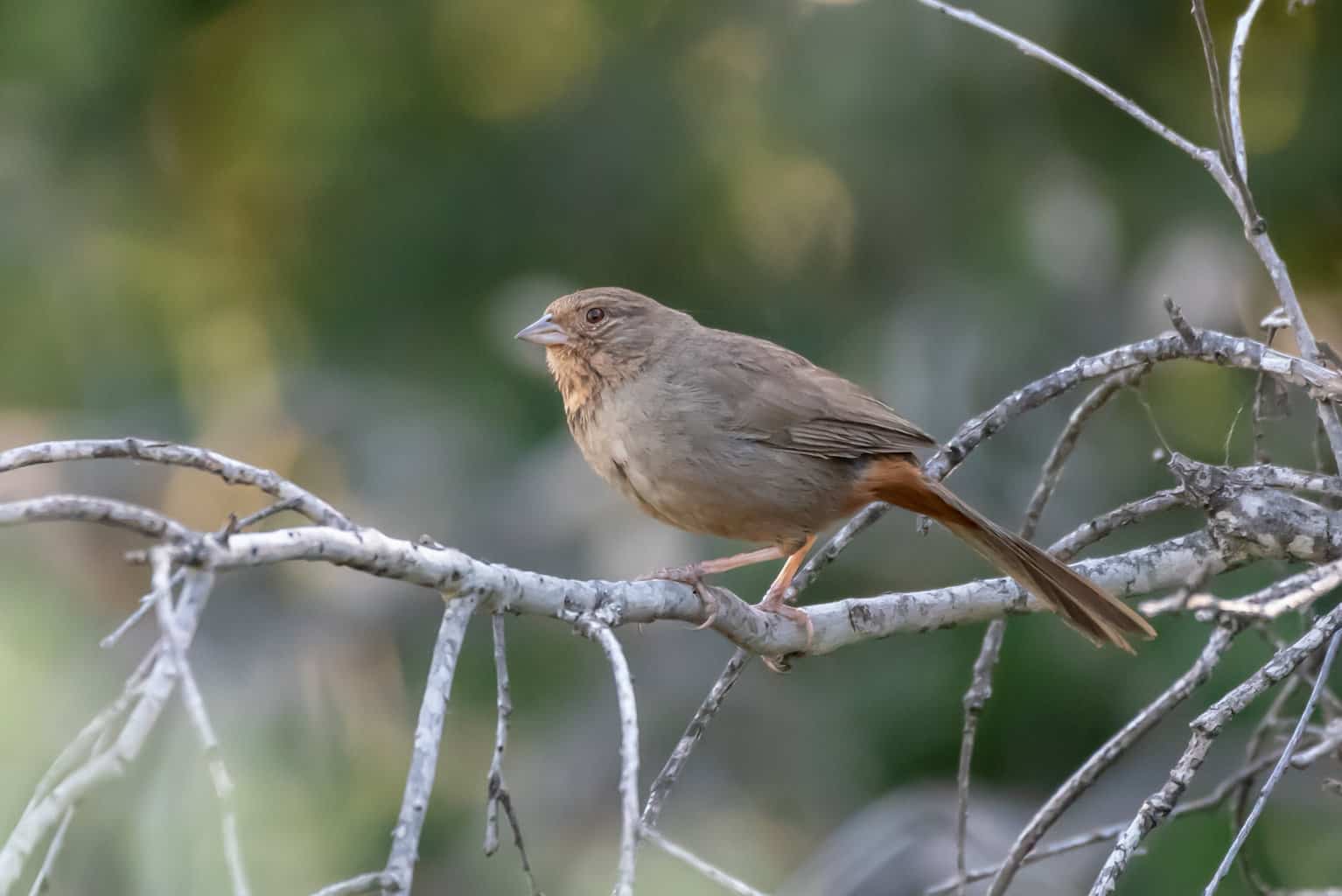
- Scientific Name: Melozone crissalis
- Family: Passerellidae
- Order: Passeriformes
- Weight: 1.2-1.5 oz (34-42 grams)
- Length: 7.5-8.7 in (19-22 cm)
- Wingspan: 10-11 in (25-28 cm)
The California Towhee (Melozone crissalis) has only subtle distinctions between males and females. Males have warm cinnamon-brown plumage, with their wings and tail displaying darker tones. Females, on the other hand, have a similar color palette, but their feathers often appear slightly lighter and more subdued.
Compared to other sparrows and towhees, the California Towhee is quite muted in its appearance.
Although it is far more common in California, there are some parts of Oregon that see these birds year-round. Watch for them in dense shrubby areas, such as coastal sagebrush and oak woodlands, where they can forage for seeds and insects among the understory vegetation.
Interesting facts about California Towhee:
- It is known for its rich and melodic song, which resembles a series of clear whistles and trills. Their vocalizations contribute to the vibrant chorus of sounds in their habitat.
- Despite their terrestrial nature, California Towhees are proficient scratchers, using their sturdy bills to unearth insects and seeds from the forest floor. Their foraging behavior is a testament to their resourcefulness and adaptability.
- They are known for tapping at windows, as they are aggressive when they encounter their reflection.
Dark-eyed Junco
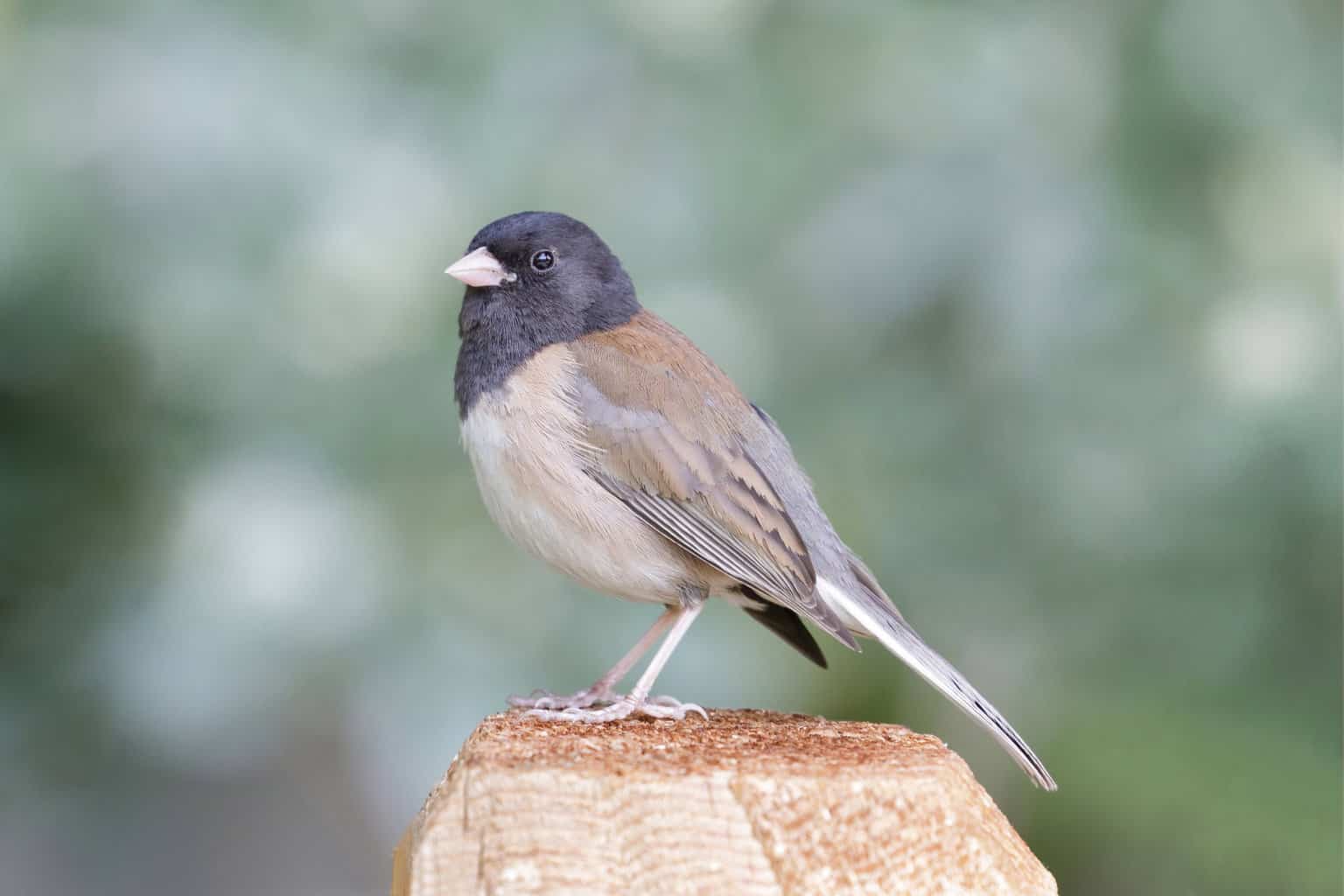
- Scientific Name: Junco hyemalis
- Family: Passerellidae
- Order: Passeriformes
- Weight: 0.6-1 oz (18-28 grams)
- Length: 5.1-6.3 in (13-16 cm)
- Wingspan: 7.9-9.8 in (20-25 cm)
The Dark-eyed Junco (Junco hyemalis) is a plump sparrow with distinct variations between individuals and different regional populations. There is an Oregon-specific variation that has a dark brown hood and a lighter brown back. The Oregon Dark-eyed Junco has a white belly and buff-colored sides.
Dark-eyed Juncos are distributed widely throughout North America. They adapt to many different habitats, including forests, woodlands, shrublands, and neighborhoods. They are often seen at backyard feeders. In Oregon, they are commonly observed in forested areas, including both coniferous and deciduous forests.
They live year-round in most of the state, but they are winter-only residents near Pendleton.
Interesting facts about the Dark-eyed Junco:
- This bird is one of North America’s most common birds, and it is one of the most common forest-dwelling birds.
- If you want to attract Dark-eyed Juncos to your feeder, they are more likely to visit feeders that are filled with millet, as opposed to sunflower seeds.
- It can take up to a week for the Dark-eyed Junco to build its nest, which is made from grasses, pine needles, twigs, and moss. After framing a “foundation” that is sturdy, the Junco lines it with soft grass, moss, ferns, and even hair.
House Sparrow
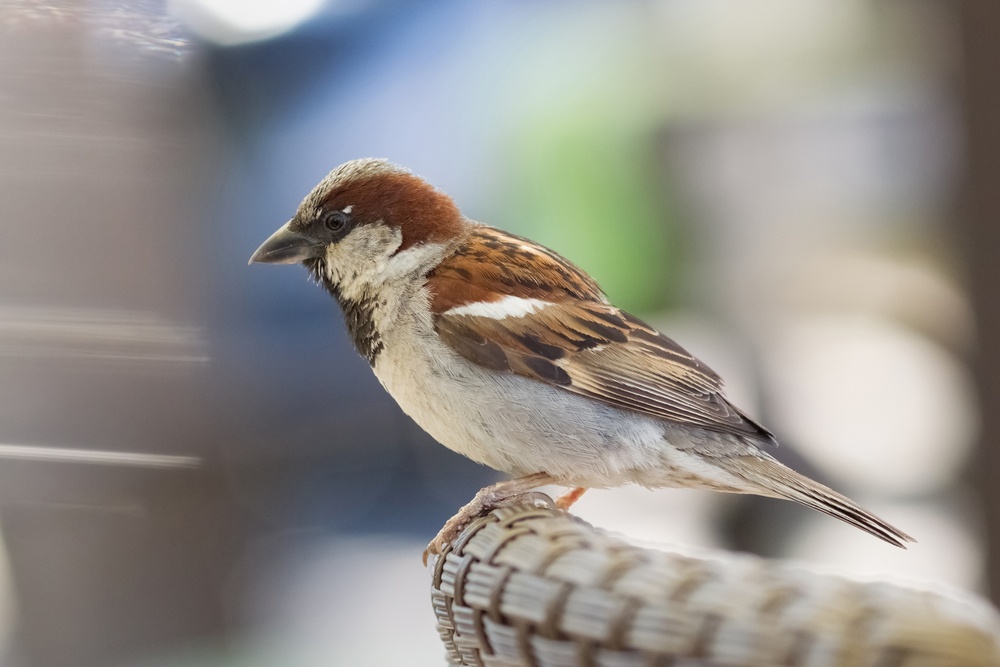
- Scientific Name: Passer domesticus
- Family: Passeridae
- Order: Passeriformes
- Weight: 1.1-1.4 oz (30-40 grams)
- Length: 5.5-6.3 in (14-16 cm)
- Wingspan: 7.9-9.1 in (20-23 cm)
The House Sparrow is another sparrow with subtle variations between males and females. The males have a gray crown and nape, complemented by a black bib on their cheeks and throat. Their wings exhibit intricate patterns of brown and black. In contrast, the females possess a more muted appearance, with light brown feathers that give them excellent camouflage skills.
The House Sparrow, with its adaptable nature, has made itself at home in various habitats across all of North America, including Oregon. Found in both urban and suburban areas, these birds frequent parks, gardens, city centers, and even agricultural landscapes. They have an affinity for human habitats and skillfully construct their nests in crevices, eaves, and other sheltered locations around buildings.
House Sparrows are invasive and very aggressive. They often outcompete native birds for habitat and food.
Interesting facts about the House Sparrow:
- Among themselves, House Sparrows are often seen in flocks known as “commensal flocks.” These flocks provide a sense of community and companionship, as the birds engage in chirping conversations and engage in playful interactions.
- The House Sparrow’s melodious chirping serves as a soothing soundtrack to urban life, bringing a touch of nature’s symphony to our daily routines.
- With their adaptability and resourcefulness, House Sparrows have established themselves as one of the most widely distributed bird species globally. Their ability to thrive alongside human populations speaks to their remarkable resilience and tenacity.
Song Sparrow

- Scientific Name: Melospiza melodia
- Family: Passerellidae
- Order: Passeriformes
- Weight: 0.8-1.1 oz (22-31 grams)
- Length: 5.9-7.5 in (15-19 cm)
- Wingspan: 7.9-9.8 in (20-25 cm)
There are some small differences between the male and female Song Sparrow (Melospiza melodia). Males typically show off a warm brown overall coloration, accompanied by streaks of darker brown on their back and sides. Females have a similar pattern but tend to be slightly duller in comparison.
This musical sparrow is a common resident of Oregon, found in multiple different habitats, including wetlands, marshes, meadows, and brushy areas. They thrive near water sources, such as streams or ponds, where they can utilize the surrounding vegetation for nesting and foraging.
Interesting facts about the Song Sparrow:
- The Song Sparrow has impressive vocal prowess, as they are known for their melodious and varied songs. Each male develops a unique repertoire of tunes, showcasing their individuality.
- Song Sparrows are skilled nest builders, constructing intricate structures with grass, leaves, and other plant materials. Their nests are often located near the ground, well hidden amidst native vegetation, providing safety for their eggs.
Spotted Towhee
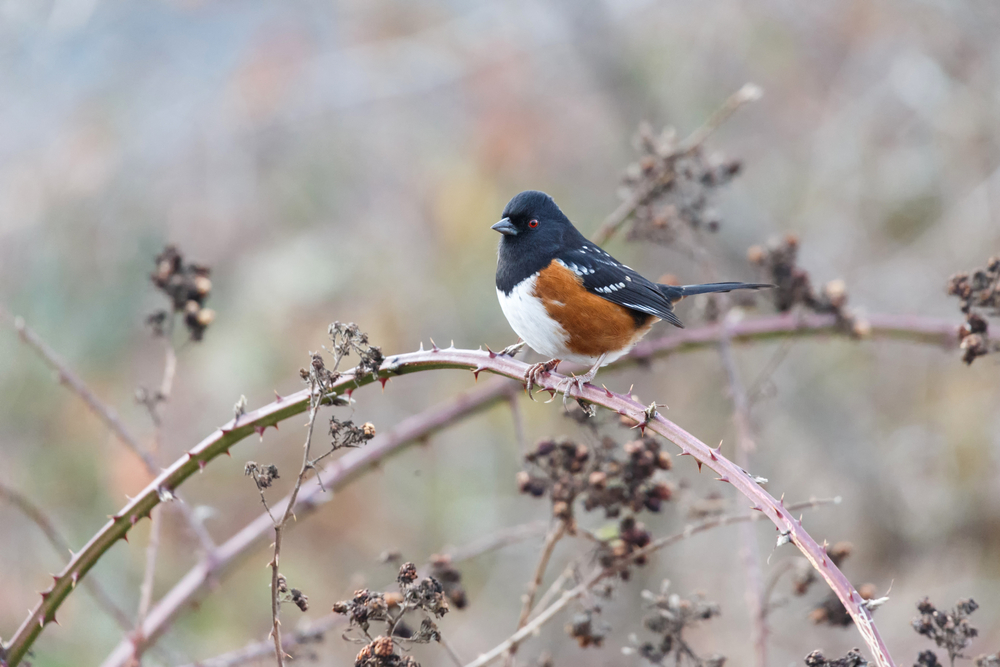
- Scientific Name: Pipilo maculatus
- Family: Passerellidae
- Order: Passeriformes
- Weight: 1.1-1.5 oz (30-42 grams)
- Length: 7.1-8.3 in (18-21 cm)
- Wingspan: 8.7-10.2 in (22-26 cm)
Meet the dramatically patterned Spotted Towhee (Pipilo maculatus), which exhibits distinct sexual dimorphism. Males feature striking black plumage with bold white spots on their wings, back, and tail. Females, on the other hand, have a more understated appearance, with a warm brown coloration and fewer white spots. Both sexes have attention-grabbing red eyes.
The Spotted Towhee can be found in a wide variety of habitats across Oregon, including woodlands, thickets, and shrubby areas. They particularly favor areas with dense understory vegetation, such as deciduous forests or riparian zones.
Most Spotted Towhees in Oregon are here year-round, but a few travel into the area for the winter after spending the summer in the Interior West.
Interesting facts about the Spotted Towhee:
- They have a distinctive scratch-and-kick foraging technique, where they use their strong feet to uncover insects, seeds, and other tasty morsels from the forest floor.
- With their rich, musical songs, Spotted Towhees make a mix of trills, whistles, and buzzy notes.
Sparrows in Oregon During the Summer
Several sparrows are found in Oregon during the summer. including the Black-throated Sparrow, the Brewer’s Sparrow, the Chipping Sparrow, the Grasshopper Sparrow, the Green-tailed Towhee, the Lark Sparrow, the Sagebrush Sparrow, the Savannah Sparrow, and the Vesper Sparrow.
Don’t forget that you may also see the year-round sparrows in the summer, so a comprehensive list of summer sparrows will include the year-round residents, too.
Black-throated Sparrow
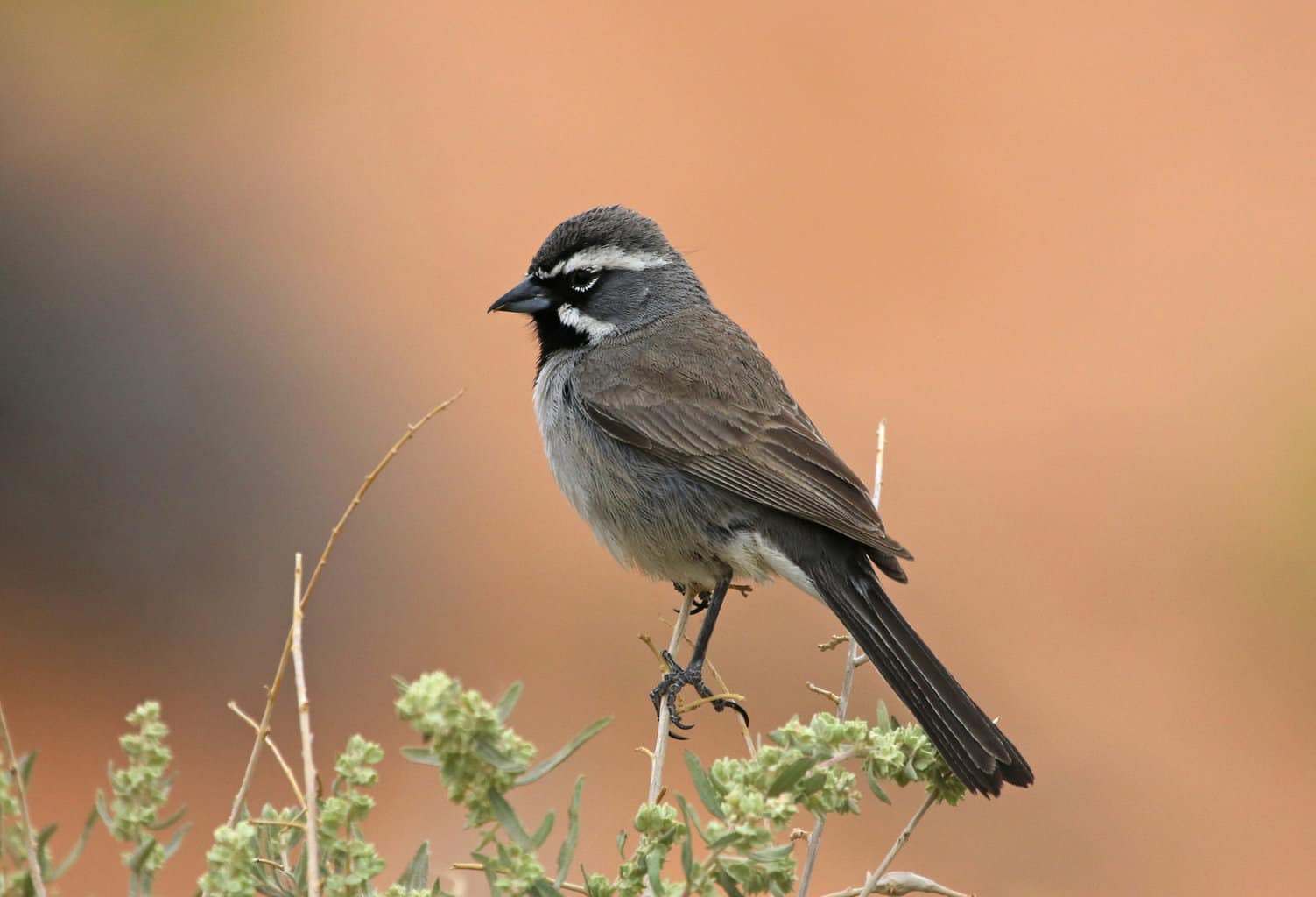
- Scientific Name: Amphispiza bilineata
- Family: Passerellidae
- Order: Passeriformes
- Weight: 0.6-0.7 oz (17-20 grams)
- Length: 5.1-5.9 in (13-15 cm)
- Wingspan: 7.5-8.7 in (19-22 cm)
The Black-throated Sparrow (Amphispiza bilineata) has distinctive features that make it easier to recognize – particularly the males. Their striking black throat patch contrasts with their crisp white underparts. Their face is a grayish color, while their back and wings display a warm sandy brown hue. Females have a similar pattern but their coloring is duller.
Black-throated Sparrows are primarily found in arid and semi-arid habitats across the western United States, including certain regions of Oregon. They are usually only found in the southeastern corner of the state, with some populations scattered centrally throughout the state.
They prefer open grasslands, desert scrub, and rocky slopes, where they can forage for seeds and insects.
Interesting facts about the Black-throated Sparrow:
- The sounds of the Black-throated Sparrow are characterized by a series of tinkling and metallic notes.
- They have evolved to withstand harsh desert environments, displaying adaptations such as specialized kidneys that allow them to excrete highly concentrated urine, conserving precious water resources.
Brewer’s Sparrow
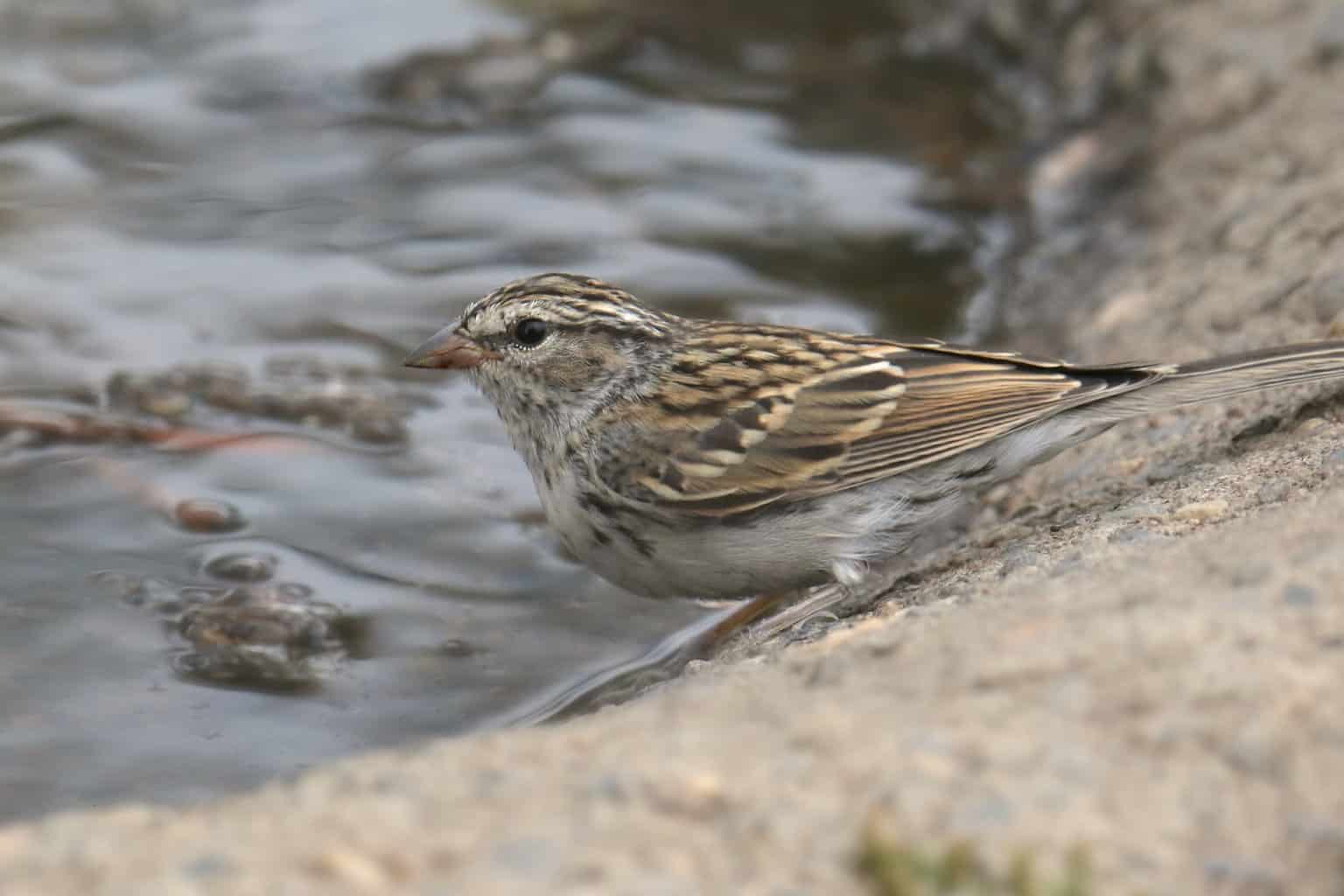
- Scientific Name: Spizella breweri
- Family: Passerellidae
- Order: Passeriformes
- Weight: 0.3-0.4 oz (9-12 grams)
- Length: 4.3-5.1 in (11-13 cm)
- Wingspan: 7.5-8.3 in (19-21 cm)
The small Brewer’s Sparrow (Spizella breweri) has subtle colors. Both males and females have a light brown overall plumage, with darker streaks on their back and wings. Their face displays a pale brown color, and they have slender bills, ideal for feeding on seeds and insects.
Brewer’s Sparrows can be found in a number of habitats throughout Oregon, including open grasslands, sagebrush steppes, and shrubby areas. However, they mostly avoid the Pacific Coast. Instead, they are particularly associated with sagebrush habitats and are often found in the company of other bird species that depend on this ecosystem.
Interesting facts about the Brewer’s Sparrow:
- These tiny birds have a melodious yet understated, simple song that is gentle and tinkling.
- Brewer’s Sparrows have a unique foraging technique known as “tail-wagging.” They flick their tail rapidly up and down while perched, which may help flush out hidden insects from the vegetation, making them easier to catch.
Chipping Sparrow
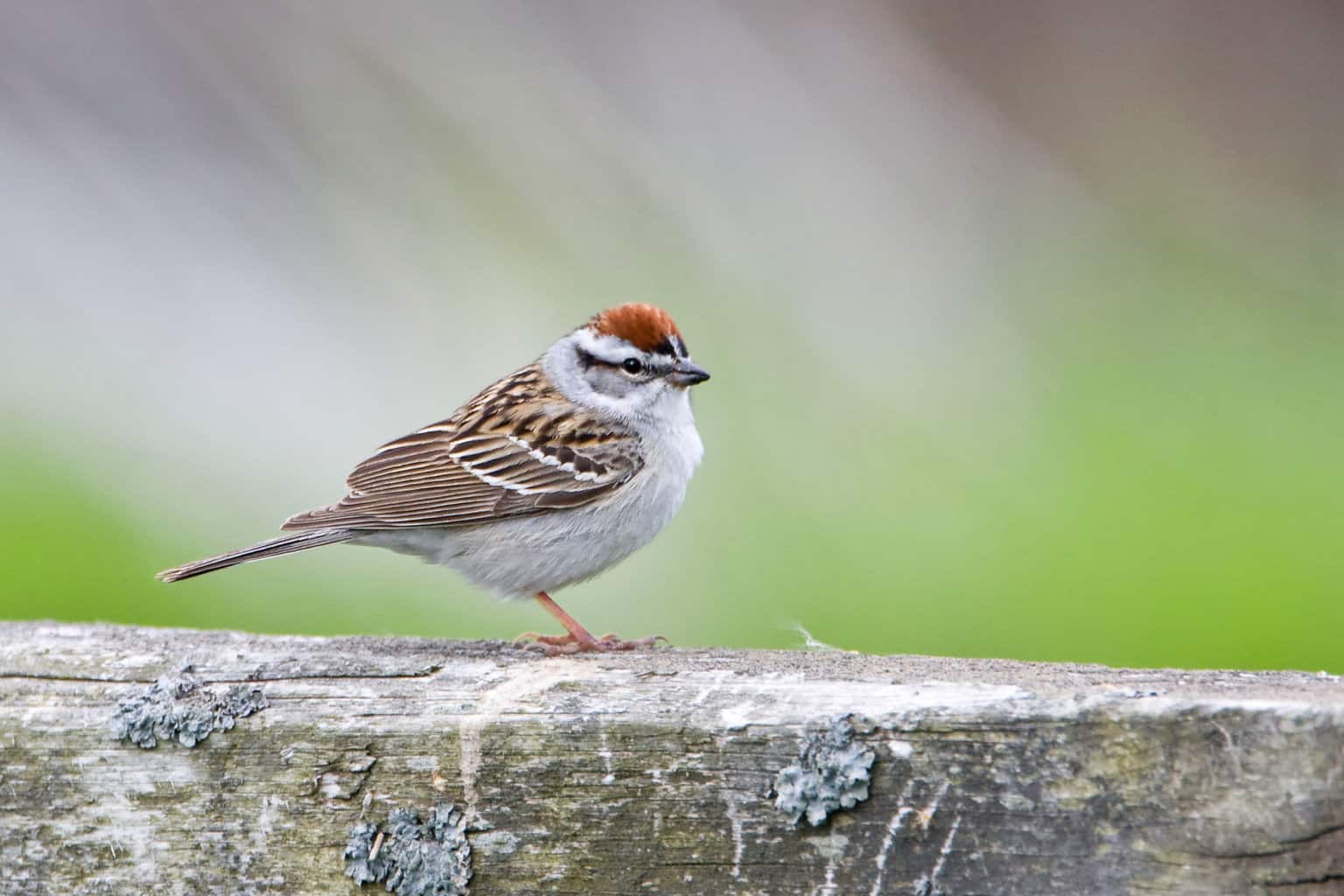
- Scientific Name: Spizella passerina
- Family: Passerellidae
- Order: Passeriformes
- Weight: 0.4-0.5 oz (11-14 grams)
- Length: 4.7-5.9 in (12-15 cm)
- Wingspan: 7.5-8.7 in (19-22 cm)
Meet the Chipping Sparrow, a charming little bird with only subtle differences between the male and female. Males have a vibrant reddish-brown crown, which contrasts with their gray face and back. Their underparts are pale grayish-white. Like other sparrows, females have a similar pattern as males, but with slightly duller colors.
Chipping Sparrows are one of the most widespread sparrows in North America during the summertime. They are present in multiple kinds of habitats, including open woodlands, forests, and even suburban areas. In Oregon, they are commonly observed in mixed forests and residential neighborhoods with sufficient tree cover.
Interesting facts about the bird:
- The Chipping Sparrow’s song is often described as a series of rapid, metallic chips. Their vocalizations are heard during the breeding season.
- Chipping Sparrows are skilled nest builders, constructing cup-shaped nests using grass, fine twigs, and other plant materials. Their nests are often located in trees or shrubs, as the cover provides protection from the elements and from predators.
Grasshopper Sparrow
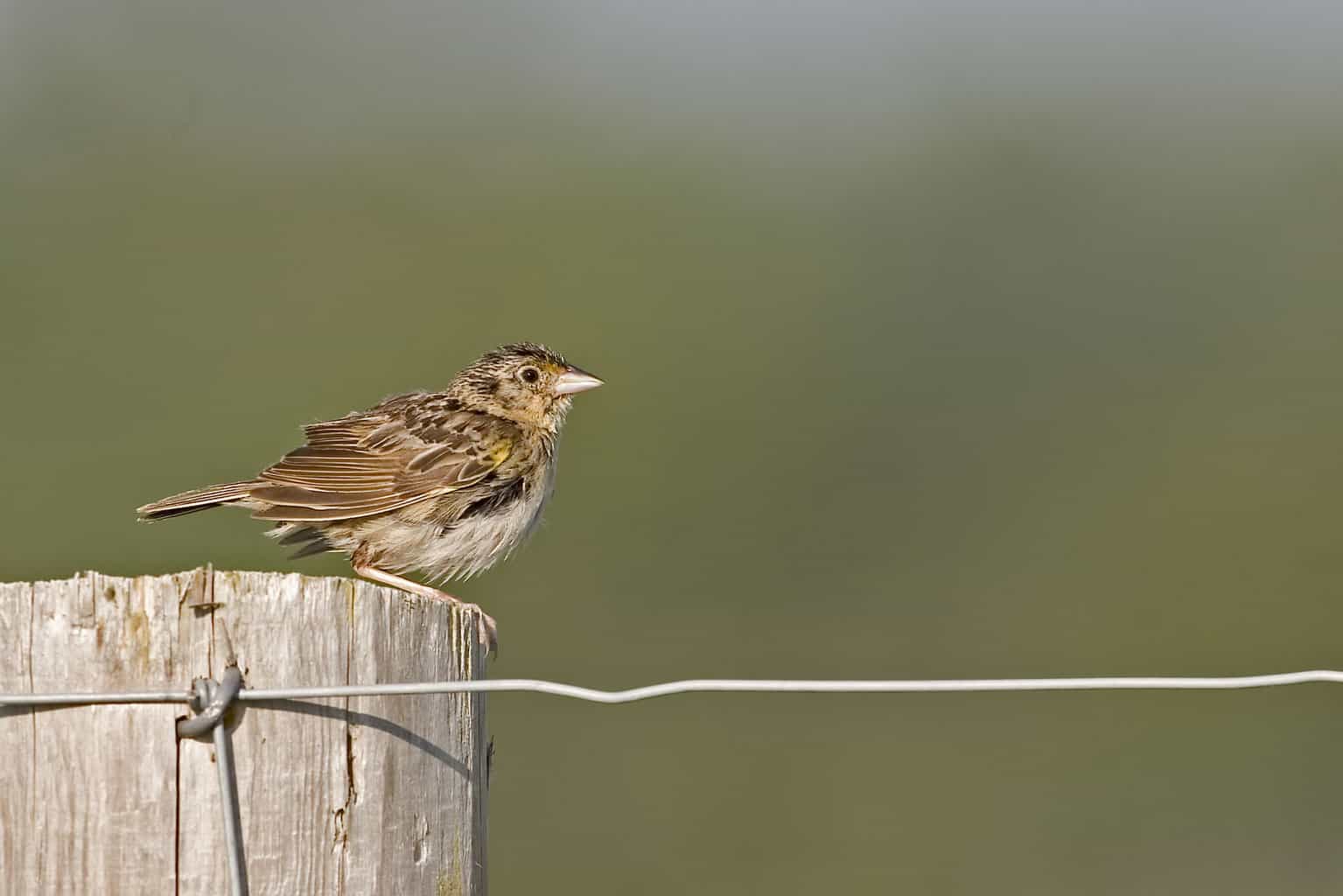
- Scientific Name: Ammodramus savannarum
- Family: Passerellidae
- Order: Passeriformes
- Weight: 0.4-0.5 oz (11-14 grams)
- Length: 4.3-5.1 in (11-13 cm)
- Wingspan: 6.7-7.5 in (17-19 cm)
The Grasshopper Sparrow (Ammodramus savannarum) is a small sparrow with a few distinctive markings. Both males and females have brownish upper parts with streaks, blending in perfectly with their preferred grassy habitat. Their underparts are pale, and they have a small, slender bill. You can also see a bit of yellow on their lores (the space between their eye and the bill).
Grasshopper Sparrows are not common in most of Oregon, but they live along the state’s northern border. They are much more common summer residents of Washington.
Interesting facts about the Grasshopper Sparrow:
- The Grasshopper Sparrow gets its name from the buzzy-like sound it makes, which is similar to a noisy grasshopper.
- Grasshopper Sparrows have a unique feeding behavior where they often forage on the ground, hopping and running through the grasses to capture insects and small invertebrates. Their low-profile foraging style makes them well-adapted to their grassland habitats.
Green-Tailed Towhee
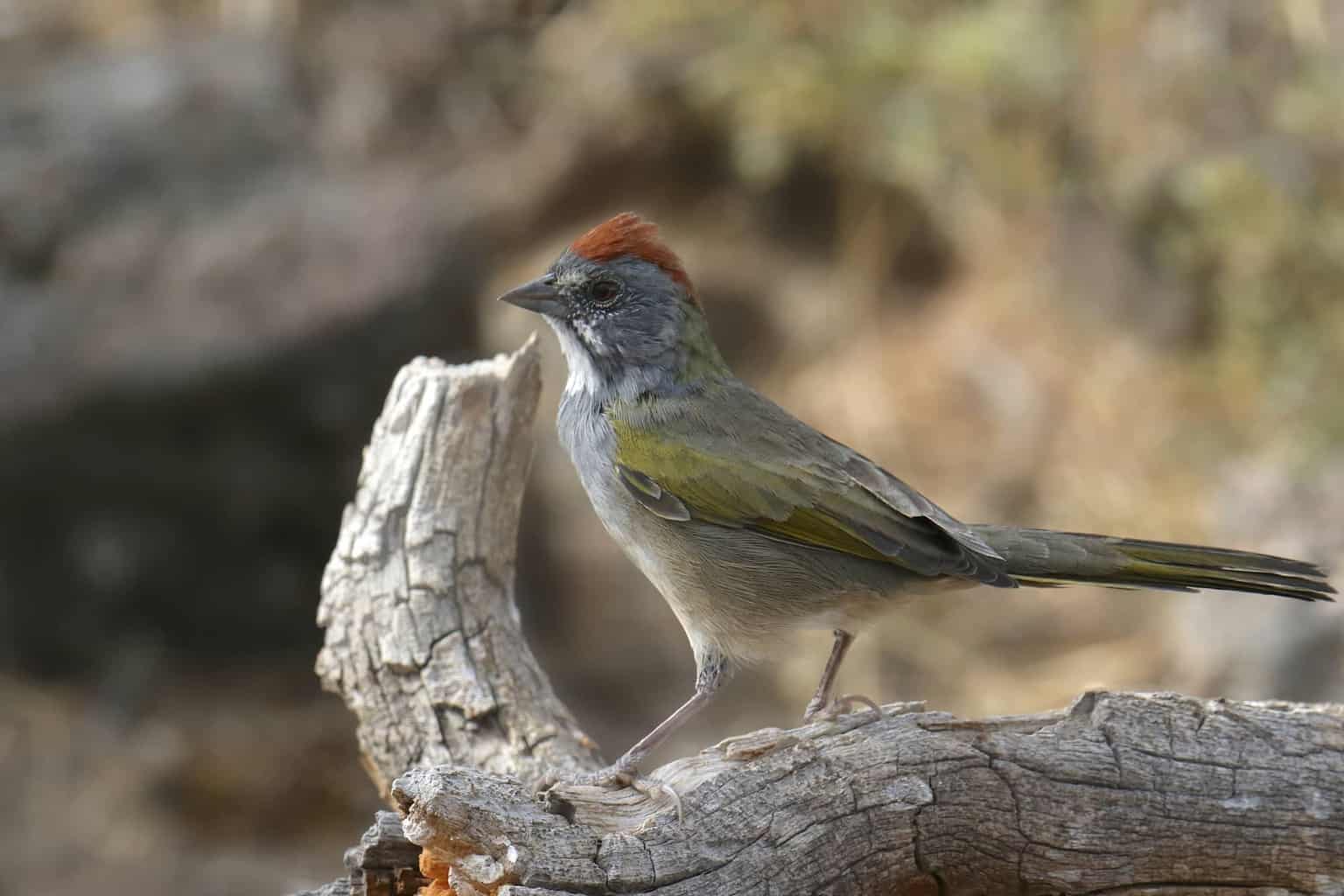
- Scientific Name: Pipilo chlorurus
- Family: Passerellidae
- Order: Passeriformes
- Weight: 1.1-1.3 oz (31-37 grams)
- Length: 6.7-7.9 in (17-20 cm)
- Wingspan: 9.1-10.2 in (23-26 cm)
The Green-Tailed Towhee (Pipilo chlorurus) is an absolutely beautiful bird – perhaps the most interesting-looking on this list! There are notable variations between males and females: Males have a rich olive-green back and tail, contrasting with their warm reddish-brown head, neck, and underparts. Females have a more muted appearance overall.
Green-Tailed Towhees can be found in montane forests and shrubby areas in the western United States, including certain regions of Oregon. They prefer habitats with dense understory vegetation, where they can forage for insects and seeds.
If you drew a line diagonally across Oregon from the southwest corner to the northeast corner, the Green-Tailed Towhee’s territory would fall to the right of that line.
Interesting facts about the bird:
- The song of the Green-Tailed Towhee consists of a series of clear, whistled notes and trills. Their vocalizations are often heard during the breeding season, as males establish territories and attract mates. That means people in Oregon are more likely to hear them than people who live where they spend the winter.
- Green-Tailed Towhees are known for their distinctive scratching behavior, where they vigorously rake through leaf litter and soil with their feet in search of insects and seeds.
- Green-Tailed Towhees migrate during the night.
Lark Sparrow
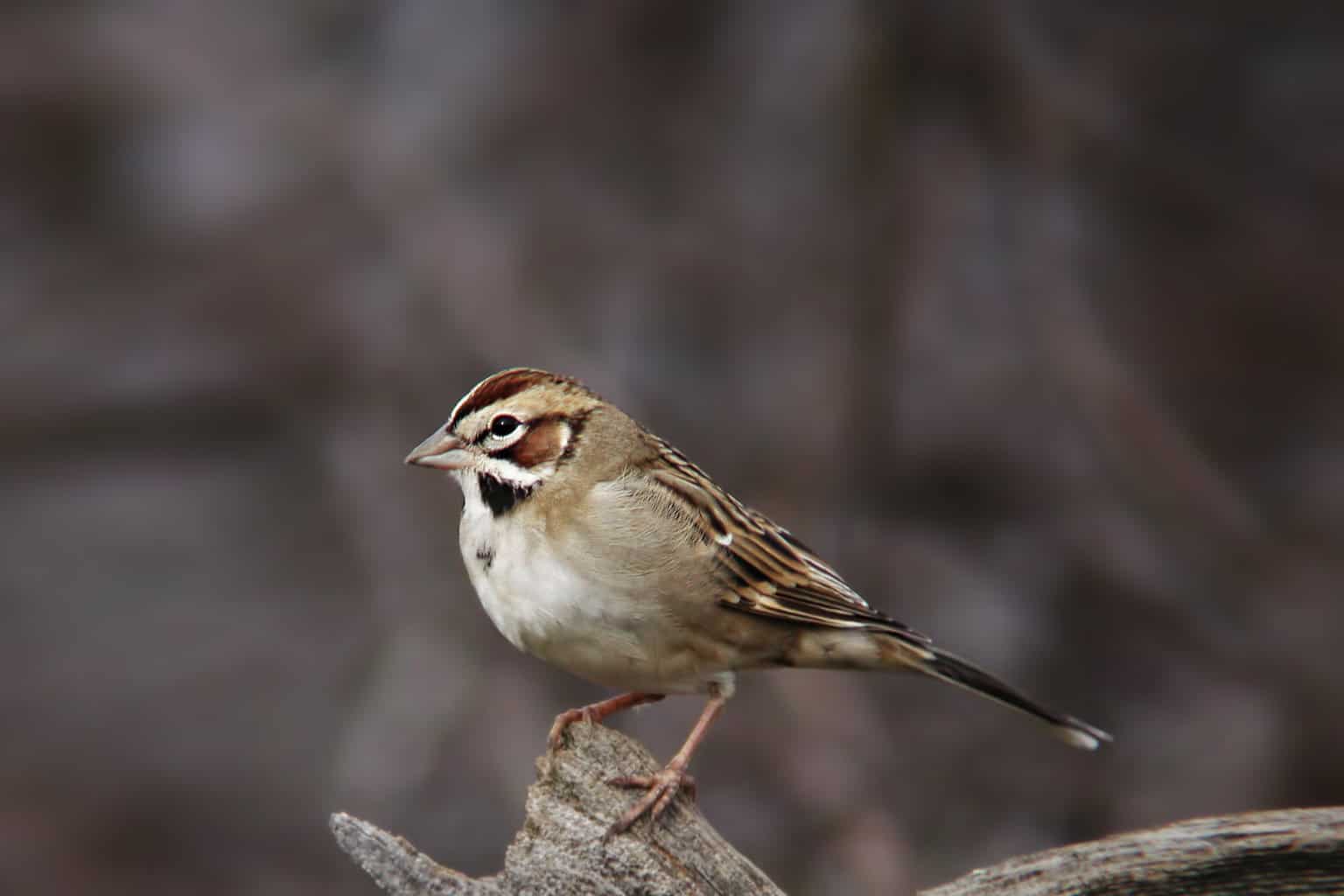
- Scientific Name: Chondestes grammacus
- Family: Passerellidae
- Order: Passeriformes
- Weight: 0.9-1.1 oz (25-31 grams)
- Length: 5.9-7.1 in (15-18 cm)
- Wingspan: 9.1-9.8 in (23-25 cm)
The Lark Sparrow (Chondestes grammacus) stands out from other sparrows. Both males and females have a striking facial pattern, with a head that is striped in dark brown (almost black) and white. Their back and wings display warm tones of brown and chestnut, while their underparts are pale with a spotted breast pattern.
Lark Sparrows can be found in plenty of different habitats, including grasslands, open fields, and scrublands. In Oregon, they are commonly observed in grassy areas with scattered shrubs or trees, such as prairies or agricultural fields.
They are year-round residents of a small area near Grants Pass, and summer-only residents of much of the rest of the state. They do not visit coastal areas.
Interesting facts about the Lark Sparrow:
- The Lark Sparrow’s beautiful song is a combination of clear whistles, trills, and buzzes.
- Lark Sparrows are known for their elaborate display flights during the breeding season. Males soar high into the air, singing and fluttering their wings, showcasing their vibrant plumage to attract a mate.
Sagebrush Sparrow
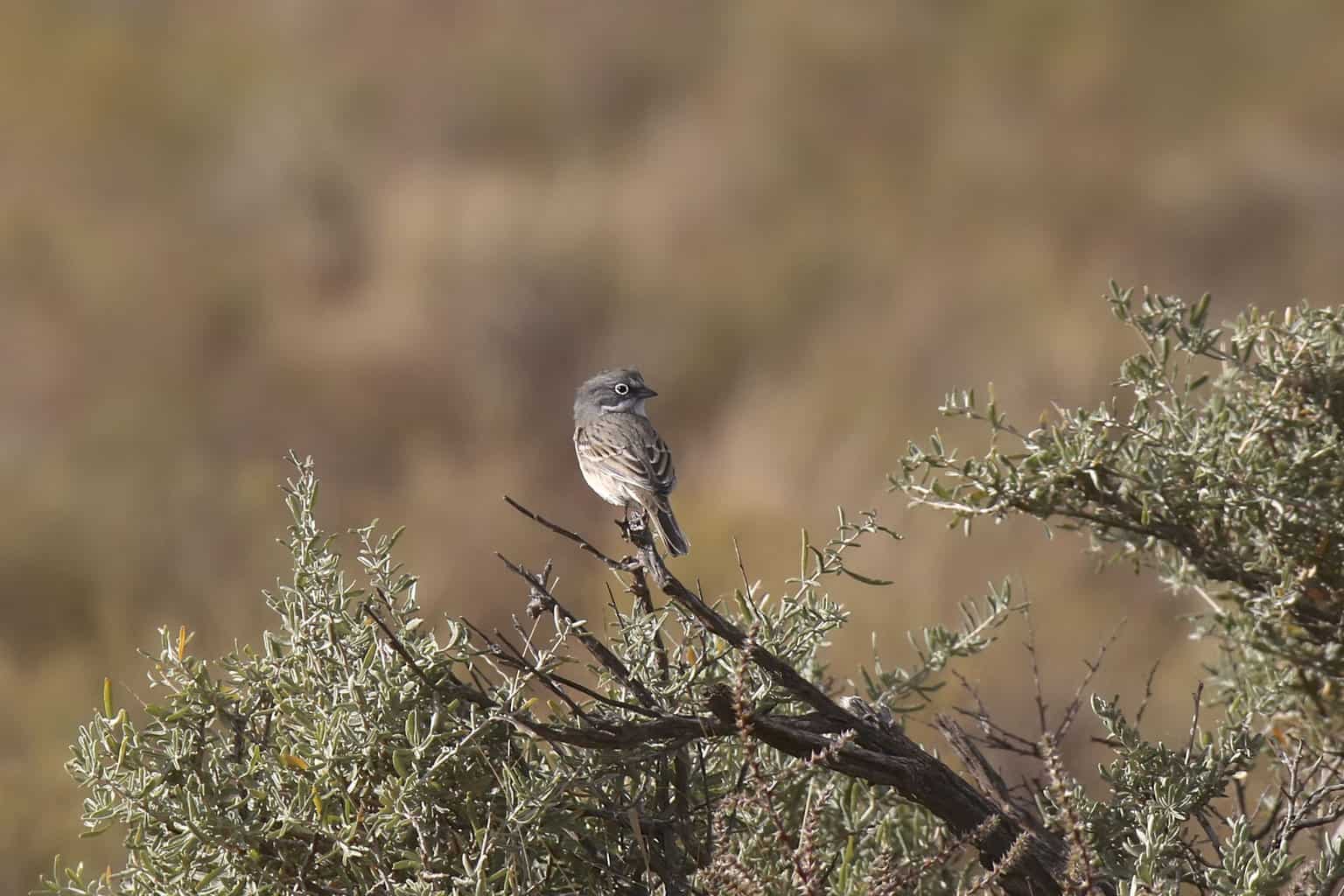
- Scientific Name: Artemisiospiza nevadensis
- Family: Passerellidae
- Order: Passeriformes
- Weight: 0.6-0.7 oz (17-20 grams)
- Length: 4.7-5.5 in (12-14 cm)
- Wingspan: 7.9-8.7 in (20-22 cm)
The Sagebrush Sparrow (Artemisiospiza nevadensis) has minimal noteworthy markings and no distinctive variations between males and females. Both sexes have a grayish-brown overall plumage, blending in perfectly with their sagebrush habitat. Males may have a slightly darker gray head and breast compared to females, but generally, it is not possible to distinguish males and females from one another.
Sagebrush Sparrows are primarily associated with sagebrush habitats in the western United States, as their name implies. Including certain regions of Oregon like the Steens Mountain Wilderness area. They are typically found in arid or semi-arid areas – as long as there is sagebrush nearby.
Interesting facts about the Sagebrush Sparrow:
- During the summer months, when they are found in Oregon, Sagebrush Sparrows are opportunistic feeders. That means they will eat just about anything, including insects, grasshoppers, beetles, seeds, fruits, and more.
- The call of a Sagebrush Sparrow is a “tink” sound. You may hear it in the mornings when the males are perching and calling.
Savannah Sparrow

- Scientific Name: Passerculus sandwichensis
- Family: Passerellidae
- Order: Passeriformes
- Weight: 0.5-0.8 oz (14-22 grams)
- Length: 4.7-6.3 in (12-16 cm)
- Wingspan: 7.9-9.1 in (20-23 cm)
The medium-sized Savannah Sparrow (Passerculus sandwichensis) has a notched tail and quite a bit of variety in appearance from one individual to the next. Their plumage can range from pale grayish-brown to rich reddish-brown. They often have a pale stripe above their eyes and streaks on their back and breast, blending in with their grassy habitat.
Savannah Sparrows have a huge summer range that spans most of the US and Canada. In Oregon, they can be found in a variety of open habitats, including grasslands, meadows, and marshes. They are also commonly observed in Oregon’s coastal grasslands, dunes, and agricultural fields.
Interesting facts about the Savannah Sparrow:
- Savannah Sparrows are highly territorial during the summer. Males establish and defend their territories with song displays and aggressive posturing.
- They are actually one of the most common songbirds in North America.
Vesper Sparrow
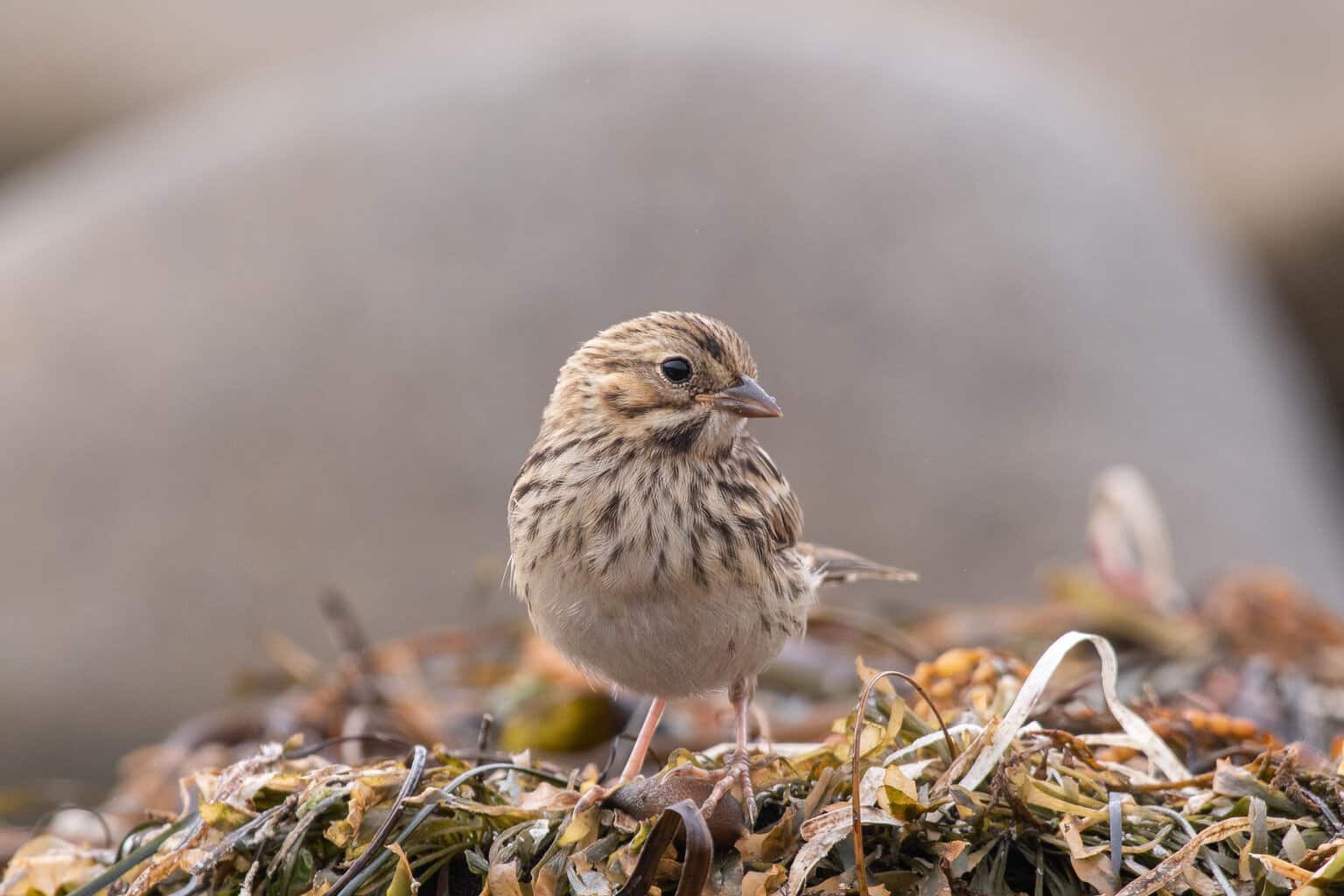
- Scientific Name: Pooecetes gramineus
- Family: Passerellidae
- Order: Passeriformes
- Weight: 0.7-1 oz (20-28 grams)
- Length: 5.9-7.5 in (15-19 cm)
- Wingspan: 10.2-11.8 in (26-30 cm)
The Vesper Sparrow (Pooecetes gramineus) is a medium-sized sparrow with fairly plain features. Both males and females have a streaked brown back and breast. They have a white eye ring, a white outer tail with conspicuous white corners, and a pale central crown stripe. Like other sparrows, Vesper Sparrows are very good at camouflage.
Vesper Sparrows tend to be found in more open habitats, instead of areas with a lot of cover. That includes grasslands, fields, and prairies. In Oregon, they avoid the coast and live throughout most of the rest of the state during the summer.
Interesting facts about the Vesper Sparrow:
- The Vesper Sparrow has a charming song, often heard during the early morning or late evening hours. Their vocalizations consist of a series of clear, ringing notes. It gets its name from the fact that it sings at the same time as the traditional Christian vesper prayer service.
- Vesper Sparrows are ground-nesting birds, constructing their nests on the ground among dense vegetation. They line their nests with fine grasses and often build a dome-like structure for protection against predators.
Sparrows in Oregon in the Winter
Some sparrows arrive in Oregon in the fall to spend the winter. These are the American Tree Sparrow, the Fox Sparrow, the Golden-crowned Sparrow, the Harris’s Sparrow, the Swamp Sparrow, and the White-throated Sparrow.
American Tree Sparrow
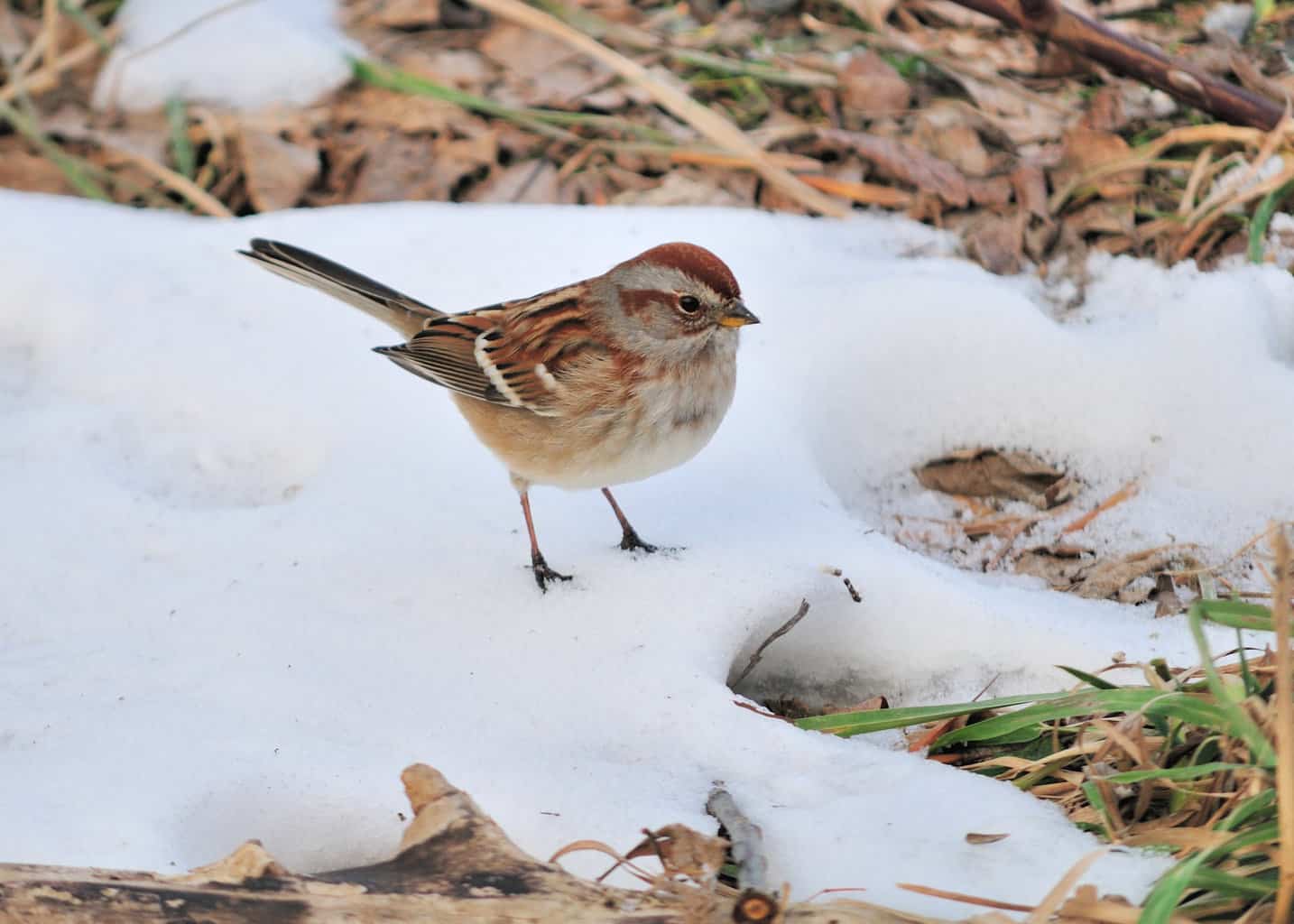
- Scientific Name: Spizelloides arborea
- Family: Passerellidae
- Order: Passeriformes
- Weight: 0.6-0.8 oz (17-23 grams)
- Length: 5.1-6.3 in (13-16 cm)
- Wingspan: 7.9-9.8 in (20-25 cm)
The American Tree Sparrow (Spizelloides arborea) is sometimes confused with the Chipping Sparrow. Both birds have a reddish-brown cap, dark streaking on their wings, and an overall brown appearance. However, the American Tree Sparrow is more rusty-brown in color, and its eyeliner is brown as opposed to the black eyeliner of the Chipping Sparrow.
American Tree Sparrows breed in the far northern regions of North America, including the Canadian tundra, and then migrate to more southerly areas during the winter. That includes Oregon, where they spend the winter in the eastern half of the state.
Interesting facts about the American Tree Sparrow:
- The American Tree Sparrow consumes 30% of its weight in food and another 30% in water every day. If the American Tree Sparrow doesn’t eat over the course of a day, it is unlikely to survive.
- American Tree Sparrows are incredibly well adapted to extremely cold temperatures, which is how they survive in the harsh winter conditions of the tundra.
Sparrows in Oregon During Migration
The last sparrows in our list are only present in the fall and spring when they are migrating between summer and winter territories. They are the Fox Sparrow, the Lincoln’s Sparrow, the Nelson’s Sparrow, the Swamp Sparrow, the Vesper’s Sparrow, and the White-crowned Sparrow.
Fox Sparrow

- Scientific Name: Passerella iliaca
- Family: Passerellidae
- Order: Passeriformes
- Weight: 1-1.6 oz (28-45 grams)
- Length: 5.9-7.9 in (15-20 cm)
- Wingspan: 9.8-11.8 in (25-30 cm)
The Fox Sparrow (Passerella iliaca) is a large, handsome sparrow with quite a lot of regional variation. Generally, they have a streaked brown back, a rusty or reddish-brown head and nape, and a pale breast with dark spots or streaks. Some subspecies may exhibit variations in coloration, including more grayish tones or brighter rufous hues.
In Oregon, Fox Sparrows are “sooty” colored and have a lot of streaking.
Although they can be found in a number of habitats, including forests, woodlands, thickets, and shrubby areas. In Oregon, they are commonly observed in forested habitats, particularly in the western and southern parts of the state during the winter.
Inland, they are summer-only residents.
Interesting facts about the Fox Sparrow:
- William Brewster, the 19th-century naturalist wrote this of the Fox Sparrow: “At all hours of the day, in every kind of weather late into the brief summer, its voice rises among the evergreen woods filling the air with quivering, delicious melody, which at length dies softly, mingling with the soughing of the wind in the spruces, or drowned by the muffled roar of the surf beating against neighboring cliffs.”
- Fox Sparrows are quite shy, so they can be difficult to spot. Watch for them along the edges of forested lands, scratching in the dirt as they forage for food.
Golden-crowned Sparrow

- Scientific Name: Zonotrichia atricapilla
- Family: Passerellidae
- Order: Passeriformes
- Weight: 1-1.3 oz (28-37 grams)
- Length: 6.3-7.1 in (16-18 cm)
- Wingspan: 8.7-9.8 in (22-25 cm)
The Golden-crowned Sparrow (Zonotrichia atricapilla) is a striking sparrow with unique and identifiable markings. They have a grayish-brown back and wings, a bright yellow crown bordered by black, and a grayish-white underbelly. Juveniles have a duller appearance and lack that obvious golden crown.
Golden-crowned Sparrows have a limited breeding territory in Alaska and northwestern Canada. During the winter, they live along the coast of the Pacific Northwest and California. In Oregon, you will see them in the western half of the state, usually in shrubby areas.
Interesting facts about the Golden-crowned Sparrow:
- Very little research has been completed on the Golden-crowned Sparrow, making its behaviors relatively unknown to naturalists and birders alike.
- Golden-crowned Sparrows have always inhabited the Yukon, which is why goldrush-era miners called them the “no gold here” bird. Its depressing little song sounded like that phrase, or “I’m so tired.” The bird’s nickname because “Weary Willie.”
Harris’s Sparrow
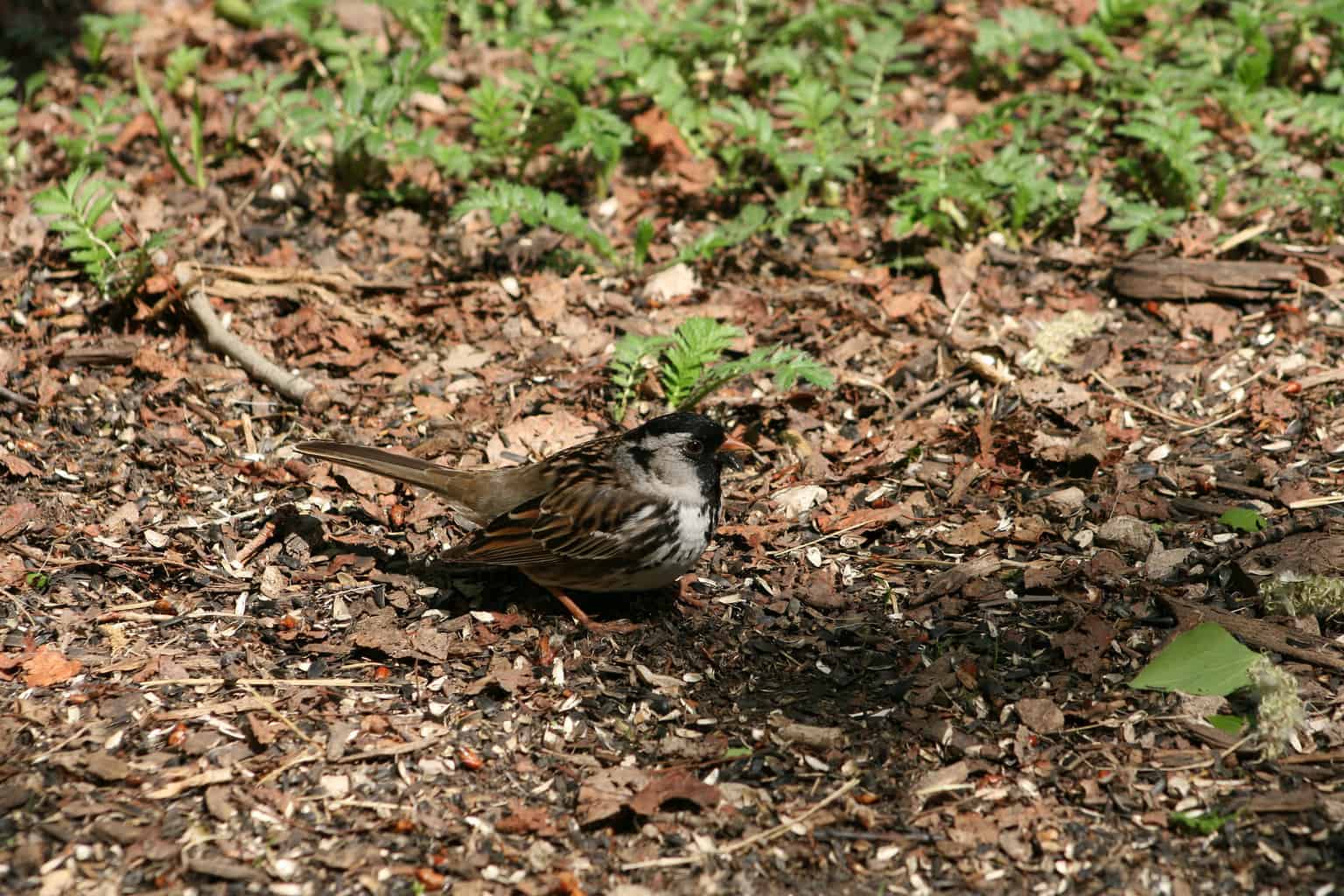
- Scientific Name: Zonotrichia querula
- Family: Passerellidae
- Order: Passeriformes
- Weight: 1.2-1.9 oz (34-54 grams)
- Length: 6.7-7.9 in (17-20 cm)
- Wingspan: 9.8-11.4 in (25-29 cm)
The Harris’s Sparrow (Zonotrichia querula) is a large sparrow with unique markings. They have a black crown, bib, and throat, contrasting with their white belly. Their back and wings are streaked with gray and brown, and they have a pink or reddish bill.
Harris’s Sparrows are usually only found in the central parts of North America, stretching from the Canadian tundra to Texas. However, they are regular visitors to Oregon, typically found in either the Columbia Basin or the Blue Mountain valleys.
Interesting facts about the Harris’s Sparrow:
- Harris’s Sparrows are known for their relatively late breeding season, often arriving at their breeding grounds when the snow is still present. Their late arrival allows them to take advantage of abundant food resources that become available as the snow melts.
- Older Harris’s Sparrows are more likely to be successful in their ability to outcompete younger birds for territory and food. This appears to be related to the size of their black bib, which gets larger as they grow. When researchers painted younger Harris’s Sparrows to have a larger bib, they were able to compete just as effectively for food as their older counterparts.
Swamp Sparrow

- Scientific Name: Melospiza georgiana
- Family: Passerellidae
- Order: Passeriformes
- Weight: 0.6-0.9 oz (18-25 grams)
- Length: 4.7-5.9 in (12-15 cm)
- Wingspan: 7.9-9.1 in (20-23 cm)
The Swamp Sparrow (Melospiza georgiana) has a rusty or reddish-brown back, wings, and tail, blending in with their wetland habitats. They have a grayish face, a pale throat, and a dark breast with reddish-brown streaks.
Swamp Sparrows inhabit wetland areas such as marshes, swamps, and bogs. In Oregon, they can be found in suitable wetland habitats along the coast, including coastal marshes, riverine wetlands, and freshwater marshes. They do not generally travel inland.
Interesting facts about the Swamp Sparrow:
- Swamp Sparrows are adept at foraging in dense vegetation and have adaptations – such as long legs – that allow them to navigate through reeds and cattails. They primarily feed on insects, spiders, seeds, and plant material found within their wetland habitats.
White-throated Sparrow
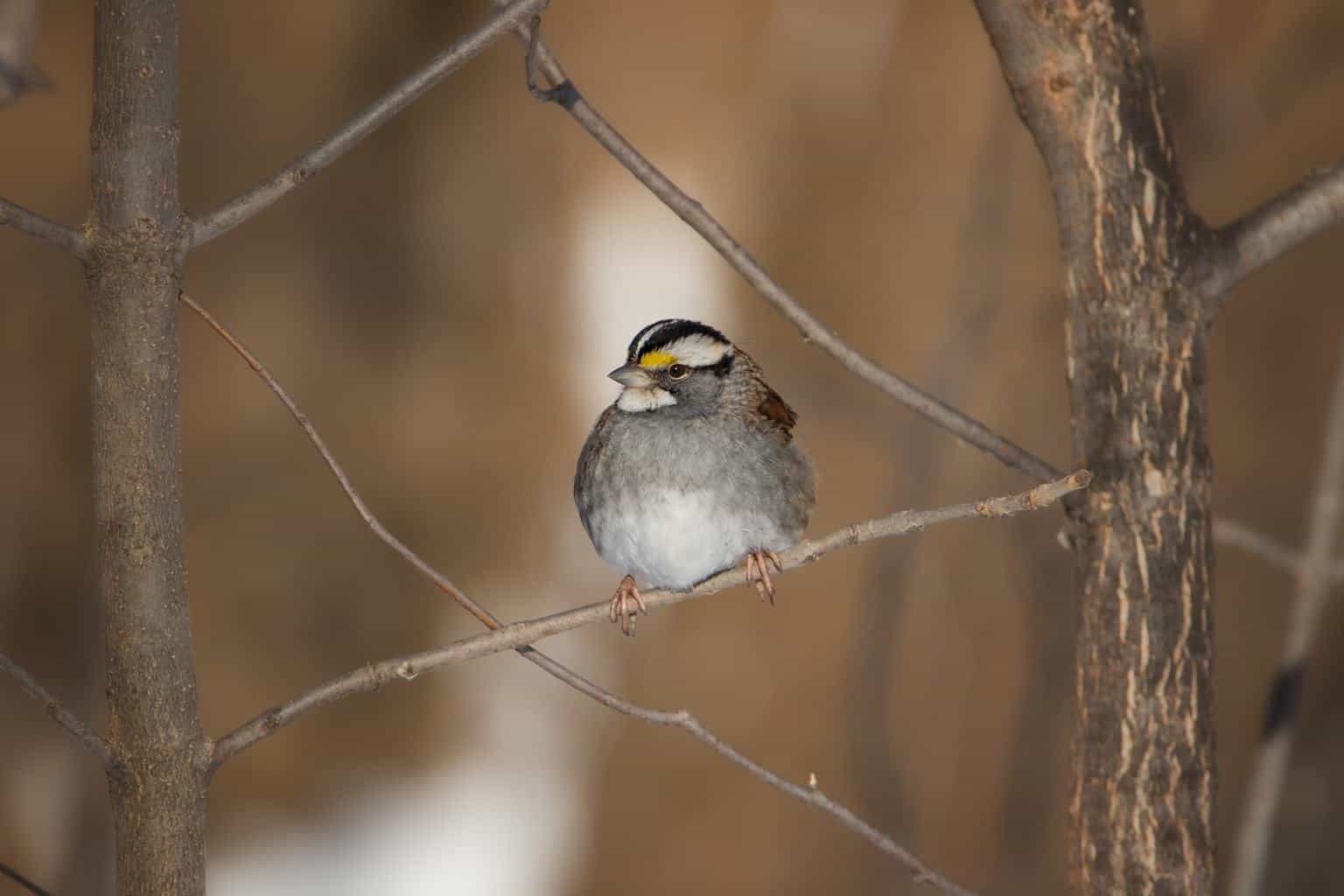
- Scientific Name: Zonotrichia albicollis
- Family: Passerellidae
- Order: Passeriformes
- Weight: 0.8-1 oz (23-28 grams)
- Length: 5.9-6.7 in (15-17 cm)
- Wingspan: 7.9-9.1 in (20-23 cm)
The White-throated Sparrow (Zonotrichia albicollis) is a medium-sized sparrow with distinct markings. They have a grayish-brown back, wings, and tail, a white belly, and a striking white throat patch bordered by black stripes. They also have a yellow spot between their eye and bill – this area is called the lore.
They are winter residents of Oregon and are found in the west, along the coastline. They are much more common in the eastern half of the US.
Interesting facts about the bird:
- White-throated Sparrows are strongly associated with Canada. They have a song that is described as singing, “Oh sweet Canada, Canada, Canada.”
- White-throated Sparrows display distinct color morphs, with individuals either having bright white stripes or tan stripes on their heads. This color variation is determined by genetic factors and has no relation to age or sex.
Enjoy Identifying Sparrows in Oregon
Now that you know about these 20 different kinds of sparrows, you can start learning to differentiate them from one another.
Don’t forget, if you’re a keen bird watcher then check out our other Oregon bird guides, including:
- A general guide to birds in Oregon
- Woodpeckers in Oregon
- Hummingbirds in Oregon
- Ducks in Oregon
- Hawks in Oregon
- Owls in Oregon
Good luck with your birding adventures in the Beaver State!

